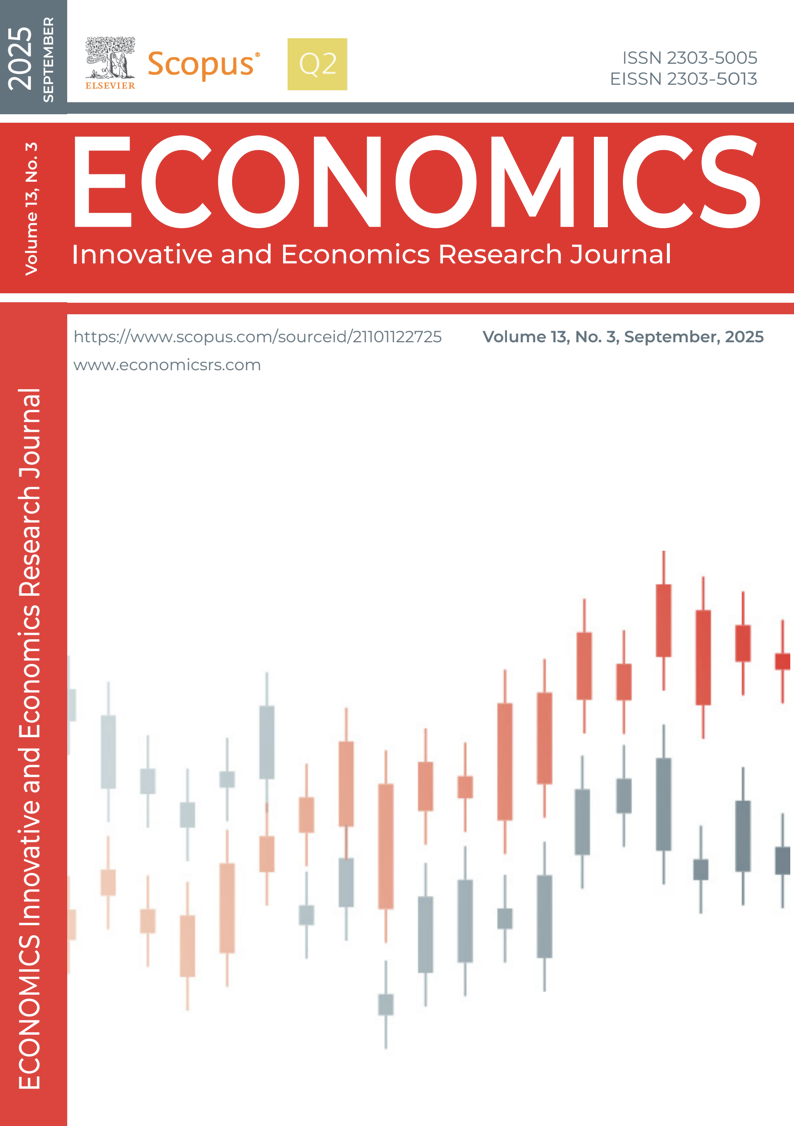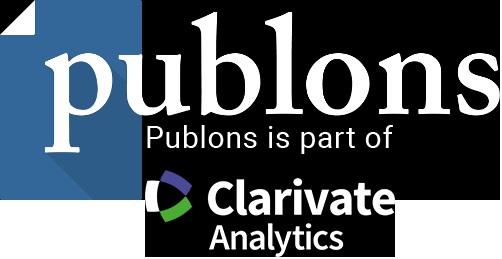PANEL INVESTIGATION OF THE FACTORS DETERMINING THE SUPPLY OF BANK LOANS IN BULGARIA USING MICROECONOMIC DATA
DOI:
https://doi.org/10.2478/eoik-2025-0076Keywords:
bank lending, bank loans supply, bank efficiency, panel econometrics, panel ARDL, cointegration, error-correction term, Pooled Mean Group Estimation of PanelsAbstract
This paper studies the factors affecting Bulgarian commercial banks’
loan supply over the period between Q1 2007 and Q4 2024. The anal-
ysis employs a panel of indicators derived from individual (micro-
economic) commercial banks’ balance sheets and income statements,
alongside macroeconomic variables. Combining cointegrated I(0) and
I(1) data suggests the use of the Pooled Mean Group (PMG) ARDL
model in panel data of Pesaran, et al. (1999). Our main findings are that
the capital adequacy ratio (CAR), cost-to-income ratio (CTOI), yield
on government bonds, and return on assets (ROA) exhibit negative as-
sociation with loan growth, while market share (MS), loan-to-deposit
ratio, interest rate on liabilities, GDP growth, housing prices, and infla-
tion positively influence lending activity. The negative value of the Er-
ror-correction term of -0.11 and the p-value of 0.016 support the validi-
ty of a long-run relationship, indicating that loan growth adjusts toward
the equilibrium state at a speed of 11% per quarter. Short-run dynamics
reveal that changes in CAR, market share, and loan-to-deposit ratios
significantly affect loan growth, while bank lending, economic growth,
and bank efficiency indicators display lagged effects. The results of this
study offer important insights into the operation of credit markets in
small, open, and bank-dependent economies such as Bulgaria.
References
Alper, K., Hulagu T. & Keles G. (2012). An Empirical Study on Liquidity and Bank Lending, Working
Paper No: 12/04, Central Bank of the Republic of Turkey. https://www.tcmb.gov.tr/wps/wcm/
connect/EN/TCMB+EN/Main+Menu/Publications/Research/Working+Paperss/2012/12-04
Altar, A., Kubinschi, M. N., & Zaharia, A. (2021). Uncovering the Dynamic Relationship between Cred-
it and Sustainable Economic Growth in Selected CEE Countries. Sustainability, 13(11), 6349.
https://doi.org/10.3390/su13116349
Altavilla, C., Boucinha, M., Holton, S., & Ongena, S. (2021). Credit supply and demand in unconven-
tional times. Journal of Money, Credit and Banking, 53(8), 2071-2098. https://doi.org/10.1111/
jmcb.12714
Altavilla, C., Boucinha, M., Peydró, J. L., & Smets, F. (2020). Banking supervision, monetary policy
and risk-taking: big data evidence from 15 credit registers. ZBW - Leibniz Information Centre
for Economics, Kiel, Hamburg. https://hdl.handle.net/10419/228461
Arellano, M., & Bover, O. (1995). Another look at the instrumental variable estimation of error-components
models. Journal of Econometrics, 68(1), 29–51. https://doi.org/10.1016/0304-4076(94)01642-D
Baltagi, B. H. (2021). Econometric analysis of panel data (6th ed.). John Wiley & Sons. https://doi.
org/10.1007/978-3-030-53953-5
Banai, A., Kiraly, J & Nagy, M. (2011). “The demise of the halcyon days in Hungary: “foreign” and
“local” banks – before and after the crisis,” BIS Papers chapters, in: Bank for International
Settlements (ed.), The global crisis and financial intermediation in emerging market economies,
volume 54, pages 195-224. https://www.bis.org/publ/bppdf/bispap54.htm
Beck, R., Jakubik, P., & Piloiu, A. (2015). Key determinants of non-performing loans. Open Economies
Review, 26(3), 525–550. https://doi.org/10.1007/s11079-015-9358-8
Beck, T., Demirgüç-Kunt, A., & Levine, R. (2006). Bank concentration, competition, and crises: First results.
Journal of Banking & Finance, 30(5), 1581–1603. https://doi.org/10.1016/j.jbankfin.2005.05.010
Bernanke, B. S., & Blinder, A. S. (1988). Credit, money, and aggregate demand. American Economic
Review, 78(2), 435–439. https://www.jstor.org/stable/1818134
Bernanke, B. S., & Gertler, M. (1995). Inside the black box: The credit channel of monetary policy trans-
mission. Journal of Economic Perspectives, 9(4), 27–48. https://doi.org/10.1257/jep.9.4.27
Berrospide, J. M. (2012). Bank liquidity hoarding and the financial crisis: An empirical evaluation.
Finance and Economics Discussion Series, 2012–03, Federal Reserve Board. http://dx.doi.
org/10.2139/ssrn.2207754
Blundell, R., & Bond, S. (1998). Initial conditions and moment restrictions in dynamic panel data mod-
els. Journal of Econometrics, 87(1), 115–143. https://doi.org/10.1016/S0304-4076(98)00009-8
Blundell-Wignall, A., & Gizycki, M. (1992). Credit supply and monetary policy: The evidence from
Australia. Reserve Bank of Australia Research Discussion Paper, No. 9208. https://www.rba.
gov.au/publications/rdp/1992/9208/conclusions.html
Brasliņs, G., Orlovs, A., Braukša, I., & Bulis, A. (2022). GDP and lending behaviour in the Baltic states. Re-
gional Formation and Development Studies, 10(2), 31–45. https://doi.org/10.15181/rfds.v10i2.139
Chinn, M. (2011). The Financial and Economic Crisis Interpreted in a CC-LM Model (revised), required
online student readings, University of Wisconsin-Madison, Economics 302-001. https://www.
ssc.wisc.edu/~mchinn/e302_creditcrisis_s11.pdf
Cornett, M. M., McNutt, J. J., Strahan, P. E., & Tehranian, H. (2010). Liquidity risk management and
credit supply in the financial crisis. Journal of Financial Economics, 101(2), 297–312. https://
doi.org/10.1016/j.jfineco.2011.03.001
De Haas, R., & van Lelyveld, I. (2006). Foreign banks and credit stability in Central and Eastern Eu-
rope: A panel data analysis. Journal of Banking & Finance, 30(7), 1927–1952. https://doi.
org/10.1016/j.jbankfin.2005.07.007
Peshev P. I. & Stamenova R. A. / Economics - Innovative and Economics Research Journal, doi: 10.2478/eoik-2025-0076
De Mello, L., & Pisu, M. (2009). The bank lending channel of monetary transmission in Brazil: A
VECM approach. The Quarterly Review of Economics and Finance, 49(2), 158–178. https://
doi.org/10.1016/j.qref.2008.02.005
Demirgüç-Kunt, A., & Huizinga, H. (1999). Determinants of commercial bank interest margins and
profitability: Some international evidence. World Bank Economic Review, 13(2), 379–408.
https://doi.org/10.1093/wber/13.2.379
Dow, S. C. (2006). Endogenous money: structuralist. A handbook of alternative monetary economics,
-51. https://www.elgaronline.com/edcollbook/9781843769156.xml#page=45
Egert, E., Backe, P. and Zumer, T. (2006). Credit growth in Central and Eastern Europe: NEW (OVER)
SHOOTING STARS?, ECB Working Paper No. 687. https://hdl.handle.net/10419/153121
Erdinç, D., 2009. From credit crunch to credit boom: transitional challenges in Bulgarian banking, 1999
– 2006, MPRA Paper 10735, University Library of Munich, Germany. https://mpra.ub.uni-
muenchen.de/10735/
Everaert, Greetje, Ms Natasha Xingyuan Che, Ms Nan Geng, Bertrand Gruss, Gregorio Impavido, Yin-
qiu Lu, Christian Saborowski, Jérôme Vandenbussche, and Mr Li Zeng. (2015). Does supply or
demand drive the credit cycle? Evidence from Central, Eastern, and Southeastern Europe. IMF
Working Paper No. 15/15. https://www.imf.org/external/pubs/ft/wp/2015/wp1515.pdf
Favero C., Giavazzi, F &Flabbi K. (1999). The transmission mechanism of monetary policy in Europe: Ev-
idence from the banks’ balance sheets, NBER Working Paper 7231. https://doi.org/10.3386/w7231
Fontana, G. (2003). Post Keynesian approaches to endogenous money: a time framework explana-
tion. Review of political economy, 15(3), 291-314. https://doi.org/10.1080/09538250308431
Frömmel, M & Karagyozova, K. (2008). Bank Lending and Asset Prices: Evidence from Bulgaria, BNB
Discussion Papers, DP65/2008. www.bnb.bg/bnbweb/groups/public/documents/bnb_publica-
tion/discussion_2008_65_en.pdf
Gambacorta, L. & Marques-Ibanez, D. (2011) The Bank Lending Channel: Lessons from the Crisis.
ECB Working Paper No. 1335. http://dx.doi.org/10.2139/ssrn.1814042
Gechev, R., Beev, I., & Hristozov, Y. (2020). Expected Effects of the Euro Adoption in Bulgaria. Eco-
nomic Studies, 29(2). https://econpapers.repec.org/RePEc:bas:econst:y:2020:i:2:p:19-44
Gennaioli, N., Martin, A., & Rossi, S. (2018). Banks, government bonds, and default: What do the data
say?. Journal of Monetary Economics, 98, 98-113. https://doi.org/10.1016/j.jmoneco.2018.04.011
Gujarati, D.N. and Porter, D.C. (2009) Basic Econometrics. 5th Edition, McGraw Hill Inc., New York.
Guo, K. & Stepanyan, V. (2011). Determinants of Bank Credit in Emerging Market Economies, IMF
Working Papers 11/051. https://www.imf.org/external/pubs/ft/wp/2011/wp1151.pdf
Halimi, E., Czakó, K., & Sahiti, A. (2025). Investigating determinants of credit growth in the case of
Kosovo: A VAR model, Journal of Infrastructure, Policy and Development 2025, 9(1), 9805.
-25. https://doi.org/10.24294/jipd9805
Heryán, T., & Tzeremes, P. G. (2017). The bank lending channel of monetary policy in EU countries during the
global financial crisis. Economic Modelling, 67, 10–22. https://doi.org/10.1016/j.econmod.2016.07.017
Hristov, K., & Mihaylov, M. (2002). Кредитна активност на търговските банки и рациониране на
кредитния пазар в България. [Credit activity of commercial banks and rationing of the credit
market in Bulgaria] Bulgarian National Bank Discussion Papers DP/23/2002. https://www.bnb.
bg/bnbweb/groups/public/documents/bnb_publication/discussion_200223_bg.pdf
Hurlin, C., & Kierzenkowski, R. (2007). Credit market disequilibrium in Poland: Can we find what we
expect?: Non-stationarity and the short-side rule. Economic Systems, 31(2), 157-183. https://
doi.org/10.1016/j.ecosys.2007.02.001
Hülsewig, O., Winker, P., & Worms, A. (2001). Bank lending and monetary policy transmission: A
VECM analysis for Germany. International University in Germany Working Paper No. 08/2001.
http://dx.doi.org/10.2139/ssrn.304457
Panel Investigation of The Factors Determining the Supply of Bank Loans in Bulgaria Using Microeconomic Data
Im, K. S., Pesaran, M. H., & Shin, Y. (2003). Testing for unit roots in heterogeneous panels. Journal of
Econometrics, 115(1), 53–74. https://doi.org/10.1016/S0304-4076(03)00092-7
IMF (2016). Czech Republic: Financial System Stability Assessment. IMF Country Report No. 16/213,
https://www.imf.org/external/pubs/ft/scr/2016/cr16213.pdf
IMF (2017). Global Financial Stability Report: Is Growth at Risk? Chapter 2: Household Debt
and Financial Stability. Washington, DC: International Monetary Fund, 136. https://doi.
org/10.5089/9781484308394.082
Jakubik, P., & Moinescu, B. (2015). Assessing optimal credit growth for an emerging banking sys-
tem. Economic systems, Elsevier, 39(4), 577-591. https://doi.org/10.1016/j.ecosys.2015.01.004
Kanapickienė, R., Keliuotytė-Staniulėnienė, G., Vasiliauskaitė, D., Špicas, R., Neifaltas, A., & Valu-
konis, M. (2023). Macroeconomic factors of consumer loan credit risk in central and eastern
European countries. Economies, 11(4), 102. https://doi.org/10.3390/economies11040102
Kao, C. (1999). Spurious regression and residual-based tests for cointegration in panel data. Journal of
Econometrics, 90(1), 1–44. https://doi.org/10.1016/S0304-4076(98)00023-2
Kapounek, S., Kučerová, Z., & Fidrmuc, J. (2017). Lending conditions in EU: The role of credit demand
and supply. Economic Modelling, 67, 285-293. https://doi.org/10.1016/j.econmod.2017.01.003
Karamisheva, T. (2021). Използване на резултатите от Анкетата за кредитната активност на банките
за обясняване на измененията в динамиката на кредита за нефинансовите предприятия в
България [Using bank lending survey results for explaining changes in the dynamics of credit
to non-financial corporations in Bulgaria]. Годишник на Стопанския факултет на СУ „Св.
Климент Охридски“, 20(1), 91-108. https://www.ceeol.com/search/article-detail?id=974854
Klein, N. (2013). Non-performing loans in CESEE: Determinants and impact on macroeconomic perfor-
mance. IMF Working Paper WP/13/72. https://www.imf.org/external/pubs/ft/wp/2013/wp1372.pdf
Kraft, E., & Jankov, L. (2005). Does speed kill? Lending booms and their consequences in Croatia.
Journal of Banking & Finance, 29(1), 105–121. https://doi.org/10.1016/j.jbankfin.2004.06.025
Levine, R. (2005). Finance and growth: Theory and evidence. In P. Aghion & S. Durlauf (Eds.), Handbook of
Economic Growth (Vol. 1, pp. 865–934). Elsevier. https://doi.org/10.1016/S1574-0684(05)01012-9
Levin, A., Lin, C. F., & Chu, C. J. (2002). Unit root tests in panel data: Asymptotic and finite-sample
properties. Journal of Econometrics, 108(1), 1–24. http://www.sciencedirect.com/science/arti-
cle/pii/S0304-4076(01)00098-7
Lavoie, M. (2000). The reflux mechanism and the open economy. In Credit, Interest Rates and the Open
Economy, 215-242. Edward Elgar Publishing. https://doi.org/10.4337/9781782542827.00023
Lavoie, M. (2006). Endogenous money: accommodationist. A handbook of alternative monetary econom-
ics, Edwar Elgar 17-34. https://www.elgaronline.com/edcollbook/9781843769156.xml#page=27
Mihaylov, M. (2017). Неравновесен модел на кредитния пазар в България [Non-equilibrium model
of the credit market in Bulgaria] Bulgarian National Bank Discussion Papers DP/107/2017.
www.bnb.bg/bnbweb/groups/public/documents/bnb_publication/discussion_2017_107_bg.pdf
Mihaylova-Borisova, G. (2023). Determinants of Credits on Private Sector in CEE Countries. Economic
Research Guardian, 13(1), 2-15. https://www.ecrg.ro/files/p2023.13(1)1y1.pdf
Mishkin, F. S. (1996). The channels of monetary transmission: Lessons for monetary policy. NBER
Working Paper No. 5464. https://doi.org/10.3386/w5464
Montoro, C., & Rojas-Suarez, L. (2012). Credit at times of stress: Latin American lessons from the glob-
al financial crisis. BIS Working Papers No. 370. https://ssrn.com/abstract=2010448
Moore, B. J. (1988). Horizontalists and Verticalists: The Macroeconomics of Credit Money. Cambridge
University Press. https://www.cambridge.org/core/publications/books
Palley, T. I. (1994). Competing views of the money supply process: theory and evidence. Metroeconom-
ica, 45(1), 67-88. https://doi.org/10.1111/j.1467-999X.1994.tb00013.x
Palley, T. I. (2002). Endogenous money: what it is and why it matters. Metroeconomica, 53(2), 152-180.
https://doi.org/10.1111/1467-999X.00138
Peshev P. I. & Stamenova R. A. / Economics - Innovative and Economics Research Journal, doi: 10.2478/eoik-2025-0076
Pedroni, P. (1999). Critical values for cointegration tests in heterogeneous panels with multiple regres-
sors. Oxford Bulletin of Economics and Statistics, 61(S1), 653–670. https://onlinelibrary.wiley.
com/doi/abs/10.1111/1468-0084.0610s1653
Pesaran, M. H., Shin, Y., & Smith, R. J. (1999). Pooled mean group estimation of dynamic heterogeneous panels.
Journal of the American Statistical Association, 94(446), 621–634. https://doi.org/10.2307/2670182
Pazarbasioglu, C. (1996) A Credit Crunch? a Case Study of Finland in the Aftermath of the Bank-
ing Crisis, IMF Working Papers 1996/135. https://www.elibrary.imf.org/view/jour-
nals/001/1996/135/001.1996.issue-135-en.pdf
Peek, J., & Rosengren, E. S. (1995). Bank regulation and the credit crunch. Journal of Banking & Fi-
nance, 19(3-4), 679–692. https://doi.org/10.1016/0378-4266(94)00148-V
Peshev, P. (2014). Фактори на кредитна динамика извън еврозоната (Factors of Credit Dynamics
Outside the Eurozone). Bulgarian National Bank Discussion series, DP/95/2014. https://papers.
ssrn.com/sol3/papers.cfm?abstract_id=2589494
Peshev, P. (2015). Моделиране на търсенето и предлагането на кредити в България [Modelling the
demand and supply of loans in Bulgaria]. Икономическа мисъл, 5/2015, 52-69. https://etj.iki.
bas.bg/storage/app/uploads/public/62a/30f/60e/62a30f60e35aa446825377.pdf
Popov, A., & Udrea, I. (2012). “Cross-border banking, credit access, and the financial crisis,” Journal of Inter-
national Economics, Elsevier, vol. 87(1), pages 147-161. https://doi.org/10.1016/j.jinteco.2012.01.008
Setterfield, M. (2017). An essay on horizontalism, structuralism and historical time. In Advances in En-
dogenous Money Analysis (pp. 398-410). Edward Elgar Publishing. https://www.elgaronline.
com/edcollchap/9781845429430.00029.xml
Stiglitz, J. E., & Weiss, A. (1981). Credit rationing in markets with imperfect information. American
Economic Review, 71(3), 393–410. https://www.jstor.org/stable/1802787
Wooldridge, J. M. (2019). Introductory econometrics: A modern approach (7th ed.). Cengage Learn-
ing. https://www.cengage.uk/c/introductory-econometrics-a-modern-approach-7e-wool-
dridge/9781337558860/
Wray, L. R. (2007). Endogenous money: Structuralist and horizontalist. Levy Economics Institute Work-
ing Paper No. 512. https://dx.doi.org/10.2139/ssrn.1010462
Downloads
Published
How to Cite
Issue
Section
License
Copyright (c) 2025 ECONOMICS - INNOVATIVE AND ECONOMICS RESEARCH JOURNAL

This work is licensed under a Creative Commons Attribution-NonCommercial-NoDerivatives 4.0 International License.























